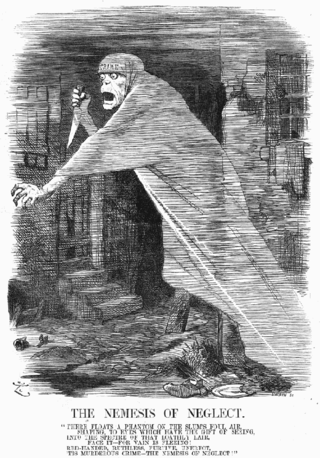Law and Crime
Jack the Ripper Identified
Unmasking Jack the Ripper more than 130 years after he vanished.
Posted January 27, 2014 Reviewed by Jessica Schrader

The legendary tale of Jack the Ripper involves five extremely brutal slayings of prostitutes between August and November of 1888 in the Whitechapel area of London, England. Legend has it that the perpetrator called himself Jack the Ripper in letters he sent to the London police—taking credit for the crimes. It was commonly believed that the Ripper was a medical doctor due to the significant cutting of the victims’ bodies.
The Ripper case was the first serial killer story in history to cause a widespread media frenzy and that was due to the proliferation of inexpensive broadsheet newspapers in Victorian London in the late 19th century. By the fall of 1888, at the height of the Ripper’s killing spree, one million newspapers with updated stories on the case were sold each day—an unprecedented circulation of newspapers at the time.
The Jack the Ripper case has generated a glut of conspiracy theories concerning his identity over the years. In fact, there are at least 100 different theories about the identity of Jack the Ripper. One of the most colorful involves a British royal family connection and the Freemasons which was depicted in the 2001 film From Hell. Indeed, much of the legend of Jack the Ripper is pure mythology.
I believe that Jack the Ripper was in reality a poor, insane tradesman and Polish Jew with homicidal tendencies called “David Cohen” who was admitted to the Colney Hatch Lunatic Asylum in London, December 1888. He died in the asylum in October 1889. The name David Cohen is a pseudonym similar to “John Doe” that was given to him because his actual name was never determined or at least not recorded.
Here is my rationale for identifying David Cohen as Jack the Ripper. First and foremost, forensic evidence supports this conclusion. In what is frequently cited as the first application of criminal profiling techniques, London physician Thomas Bond used autopsy results and crime scene evidence in the fall of 1888 to make rudimentary but skillfully informed predictions about Jack the Ripper's personality, behavioral characteristics, and lifestyle.
In his written report after examining the available forensic evidence, including the bodies, Thomas Bond concluded that “all five murders no doubt were committed by the same hand … the women must have been lying down when murdered and in every case the throat was cut first.” Bond stated that Jack the Ripper had no medical training or knowledge of anatomy, despite the killer’s extensive cutting and mutilation of his victims.
This bold statement by Bond directly opposed what law enforcement authorities had previously concluded—that Jack the Ripper was either a physician or had medical training due to the fact that he had removed internal organs from some of his victims. Bond reached his conclusion after noting that the gaping wounds inflicted by the Ripper were not consistent with the training of a medical expert or “even the technical knowledge of a butcher or horse slaughterer.”
In the opinion of Bond, the murderer must have been “a man of solitary habits, subject to periodic attacks of homicidal and erotic mania, and the character of the mutilations possibly indicating 'satyriasis' or uncontrollable sexual desire."
Utilizing the scientific approach to behavioral profiling created by the FBI to categorize serial predators, the Ripper was a classic “disorganized” killer. Significantly, disorganized crimes are not planned and the criminal typically leaves evidence such as fingerprints or blood at the scene of the murder. There is often no attempt to move or otherwise conceal the corpse after the murder. Disorganized criminals are often mentally ill; suffering, for example, from paranoid schizophrenia. They also frequently have deficient communication and social skills which leads them to reside on the fringes of society.
Disorganized killers will often “blitz” their victims—that is, use sudden and overwhelming force to capture and kill them. The victim’s body is usually left where the attack took place and the killer makes no attempt to hide it. In all of these regards, Jack the Ripper is a classic example of the disorganized serial killer. In fact, I suspect that he was a paranoid schizophrenic who feared and hated women. His murders demonstrated great rage toward his female victims.
The Ripper also had what is known as a signature. The signature is not required in order to commit the crime. Rather, it serves the emotional or psychological needs of the offender. The signature comes from within the psyche of the offender and it reflects a deep fantasy need that the killer has about his victims. The signature may involve mutilation or dismemberment of the victim’s body.
The signature of Jack the Ripper was the extensive hacking and mutilation of his victims’ bodies that characterized all of his murders. In addition, Jack the Ripper sometimes posed his victims’ nude bodies with their legs spread apart to shock onlookers and the police in Victorian England.
David Cohen fits the behavioral and psychological profile of Jack the Ripper almost perfectly. Cohen was admitted to the Colney Hatch Lunatic Asylum just weeks after the murder of Mary Kelly, the Ripper’s final victim. The asylum’s official records show that Cohen had "homicidal tendencies and a great hatred of women."
Cohen reportedly exhibited violent, destructive tendencies while at the asylum and had to be restrained at all times. Moreover, consistent with the traits of a disorganized killer, David Cohen was virtually non-communicative.
Also pointing to David Cohen is the fact that a leading theory of Scotland Yard at the time, and persistent to this day, says Jack the Ripper was a “low-class Polish Jew and sexual maniac living in Whitechapel.”
As noted by author and Ripper historian Martin Fido, David Cohen is the only insane Polish Jew who was committed to an asylum at the right time for the murders to stop as they did, and the only registered lunatic pauper admitted to Colney Hatch between 1888 and 1890 that fits the suspect described by Scotland Yard.
Providing additional support, the retired, legendary FBI profiler John Douglas has also concluded that David Cohen fits the profile of the Ripper and is the most likely suspect.
Although we will never be able to definitively prove it, I believe there is significant evidence that Jack the Ripper was a homicidal lunatic known only as David Cohen who died in an asylum in 1889.
Scott Bonn is a criminologist, professor, TV analyst, and best-selling author. Follow him @DocBonn on Twitter and visit his website.




